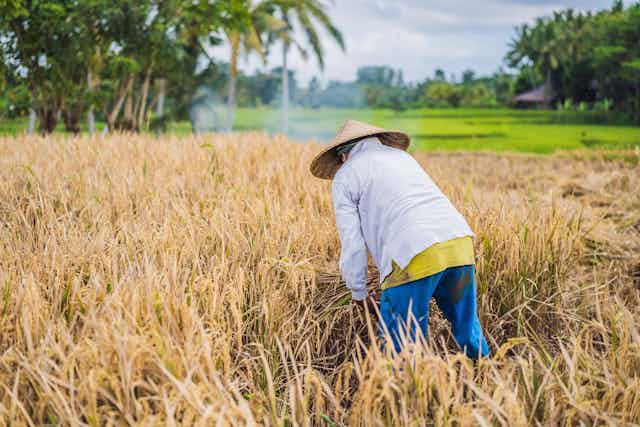For every tonne of rice produced, about a tonne of straw is grown. Given 770m tonnes of rice are produced each year, that’s a lot of straw. Some of this straw is used as livestock bedding and fodder, in building materials, or ploughed back into the soil as fertiliser. But there’s much more straw than can be used and it’s labour and cost-intensive to remove it after harvest.
This makes rice straw a major disposal problem, particularly across Asia where 90% of the world’s rice is grown, and where several million tonnes of straw are burned in rice fields each year. Although governments have made this practice illegal many farmers do it anyway, releasing greenhouse gases, harmful particles and toxic pollutants.
But colleagues and I are working on a project to transform rice straw from a waste product into a resource of renewable fuel. Our research looks at how to stop the straw burning, while improving energy access and contributing to socioeconomic development in the Philippines. Our work has shown that the straw can be gathered and processed to produce “biogas” for both domestic and commercial uses.
This is particularly important in the rural area of the Philippines where we’re working, as people don’t have easy access to sufficient and sustainable fuel. Wood and charcoal are often used for cooking, but this means deforestation, greenhouse gas emissions, and the smoke they produce reduces life expectancy and quality of life.

Our pilot plant in Laguna province takes the rice straw and turns it into biogas, a renewable energy source, using a method called anaerobic digestion. After collecting the straw from the rice fields, we feed it into two large digesters, trapping it without oxygen but with plenty of microorganisms which occur naturally and already exist in small amounts in the air and on the straw.
The idea is to replicate a process which also happens in nature when for example dead plants decay. We add small amounts of cow manure from nearby farms, to boost the amount of microorganisms and support a favourable environment for them to thrive and decompose the straw and produce biogas.
The biogas can be used for fuel. And at the end of the production process the digested straw is composted to provide a nutritious fertiliser, which can be used on fields to improve crop yield and soil quality.
Is it worth it?
But none of this matters unless local rice farmers actually think it is worthwhile. That’s why our work focuses on analysing the project’s benefits for the local community, and how bioenergy can become part of their agricultural and everyday practices.
Colleagues and I have travelled to the Philippines on numerous occasions to discuss the viability of different business models with various local groups. We considered the whole value chain from growing, harvesting and selling the rice, through to how the straw should best be gathered and handled, or how biogas could be best used. This way we can ensure that rice farmers become partners and beneficiaries, actively shaping the project and identifying possible opportunities.

For instance, we learned that farmers saw the biogas production more as an additional benefit, while they felt their main gain was solving their straw problem. We also realised the digested straw left behind after the biogas production provides a good substrate for mushroom growing, so before returning the digestate to the field, farmers could grow mushrooms and gain an additional income. That meant for us testing different ways of straw removal as well as working together with farmers to start identifying possible ways to produce mushrooms.
We tested a few different business models together with local farmers, to find out what works best in reality. The biogas plant can provide a technical solution for environmental issues, but to make it work and truly benefit the community you have to consider factors beyond technology and climate change. It also shows that regulation alone, for example on burning rice straw, won’t solve the problem – solutions must be practical and demonstate wider benefits.
If we are to enable socioeconomic development and greenhouse gas reductions, the breakthrough comes from looking at the biggest global uses and improving them in a way that people will actually deploy, because it delivers what they need as well as meeting global sustainability objectives.

